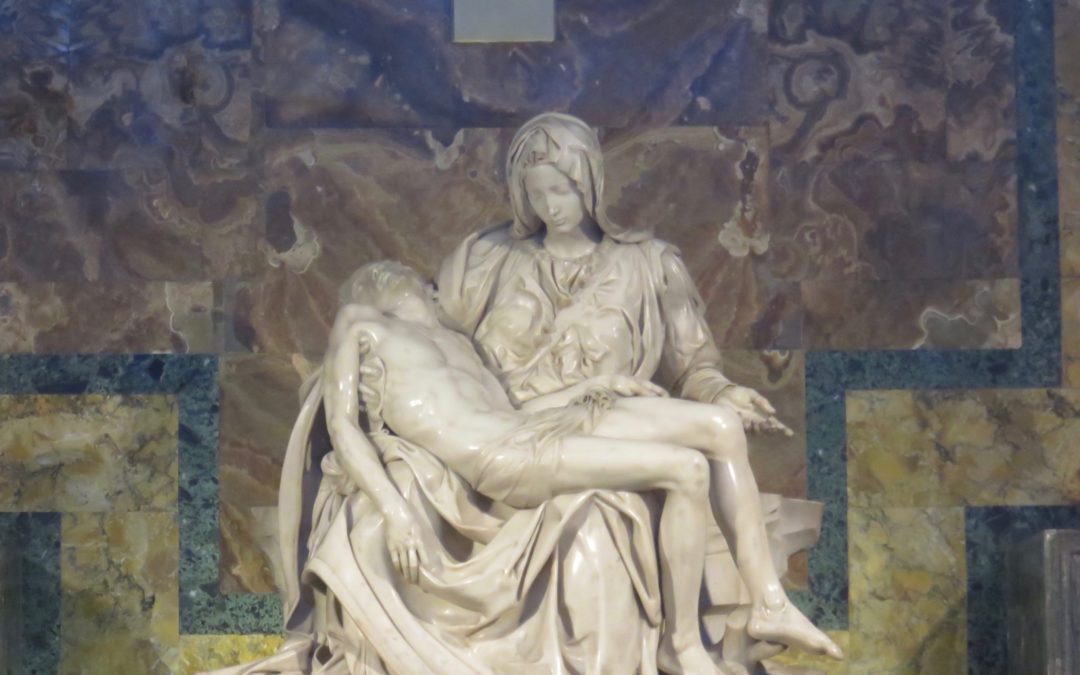Hundreds of people were packed into a side chapel in St. Peter’s Basilica in Rome when a bearded man with long, red hair suddenly scrambled over a marble railing and bolted up the stairs leading to one of the most famous works of art in the world—Michelangelo’s Pietà .
“I’m Jesus Christ!†the man shouted as he yanked a hammer from under his coat and began raining blows on the statue. Pieces of marble flew in all directions as the crowd looked on in horror.
The hammer came crashing down on the left arm of the statue of Jesus’s mother, Mary, and then the vandal smashed Mary’s face, knocking off a marble piece of her nose, left eye, and veil. In all, the man delivered about a dozen strikes with his hammer before an Italian fireman grabbed him by the hair and yanked him down from the statue.
The attack on the Pietà occurred in 1972, and the assailant was Laszlo Toth, a 33-year-old geologist from Sydney, Australia. Toth was declared mentally unfit and a “socially dangerous person,†so instead of going to prison, he was sent to a mental hospital for two years before being deported out of the country.
Pietà means “pity,†and this great statue depicts the crucified Jesus lying in the arms of His grieving mother. Michelangelo, a relatively unknown artist at the time, was only 24 years old when he sculpted the Pietà out of a single slab of Carrara marble, completing the work from 1498 to 1499.
It was the only sculpture to which Michelangelo ever signed his name.
According to a 16th-century historian, Giorgi Vasari, Michelangelo overheard some men crediting the statue to a different person, so he angrily decided to remove any doubt about who created the work of art by chiseling his name onto it. The sash that Mary wears now says: “Michelangelo Buonarroti of Florence Created This.â€
Evidently, Michelangelo always regretted signing his name to the Pietà because he saw it as glaring evidence of vanity and pride. But, in a strange way, this mark of vanity is quite fitting because Jesus died for the sins of the world, and one of the deadliest sins of all is pride.
As C.S. Lewis famously said in Mere Christianity, “The essential vice, the utmost evil, is Pride. Unchastity, anger, greed, drunkenness, and all that, are mere fleabites in comparison: it was through Pride that the devil became the devil: Pride leads to every other vice: it is the complete anti-God state of mind.â€
I also read that the figure of Jesus in the Pietà includes a “tooth of sin.†Michelangelo gave Jesus a fifth incisor, an extra tooth, and at that time an extra tooth was seen as a symbol of sin. So, by giving an extra tooth to Jesus—a tooth of sin—Michelangelo was symbolically saying that Jesus took our sins upon Himself.
I saw the Pietà in person in 2016, amidst a massive crowd that had gathered in front of a huge pane of bulletproof glass. Ever since the vandalism in 1972, the statue has been behind this protective glass.
After the vandalism, authorities tried to figure out what to do about the broken pieces, and some people argued that the Pietà should not be repaired; it should remain damaged to reflect the brokenness of this shattered world. But the statue was put back together, as art restorers carefully reattached the broken pieces. They also had to reconstruct some of the pieces because tourists who had witnessed the vandalism ran off with various fragments.
But even in the restoration we find a treasure trove of symbolism because, after all, restoration is what the crucifixion and resurrection were all about. As we go through life, we feel the hammer blows of evil, but in the end, when all is said and done, God carefully restores us and makes us new.
Maybe that’s why Michelangelo was embarrassed that he had signed his name to the Pietà . Maybe he knew that chiseling his name in stone was not the way to find true immortality. The only way to find eternal life is to put yourself in the arms of the Master Artist. Only He can truly restore us.
By Doug Peterson

